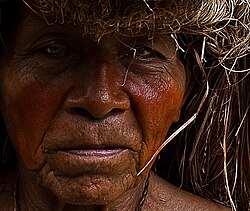Yagua
During the pre-conquest period, the Yaguas could have been in sporadic contact with the Incas, as to this day there are far more Quechua (language spoken by the Inca) words in Yagua than there are Spanish words, another hypothesis points out that Spanish missionaries imposed Quechua as the common language, a customary practice during most of the colony.
The term in Quechua would have been something like yawar runa, 'the blood-red people', which could easily have been assimilated into Spanish as yagua.
This term could have been applied to the Yaguas by the Spanish explorers because much of the native clothing is made of palm fiber.
There is no data on whether a name resembling yagua was first used by the Quechuas of the area or the Spanish, therefore there is no principled way to distinguish between these two possible etymologies.
The third earliest documented European contact with the Yagua was probably made by the Spanish explorer Francisco de Orellana in January 1542.
[4] The present extreme geographic dispersion of the Yagua, however, is due largely to the effects of the 'rubber boom' in the late 19th and early 20th centuries.
At that time Europeans arrived in large numbers from Brazil and began to exploit the indigenous people to extract natural latex from the jungle.
This fact further limits the breadth of interaction with other Yaguas, and increases the tendency to want to reach out beyond one's village for social and economic advantages.
Some children grow up speaking only Yagua, and native arts and crafts are a significant economic activity.


